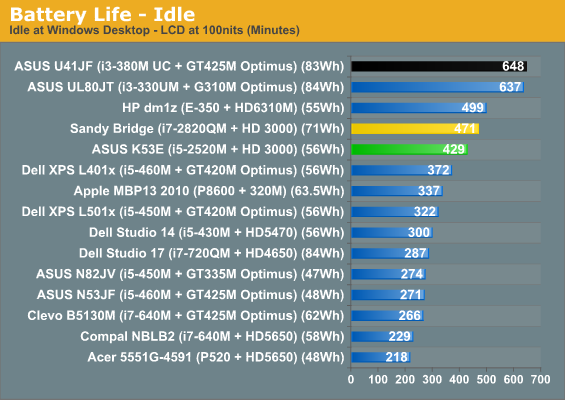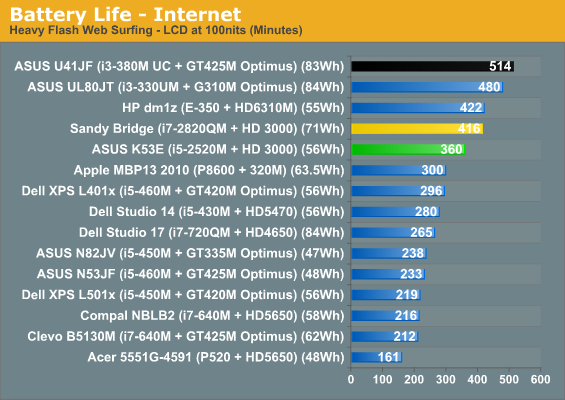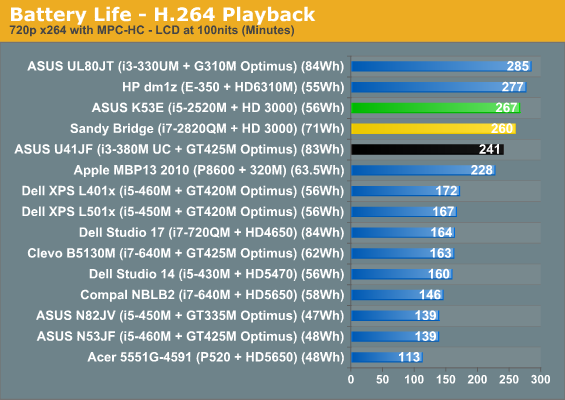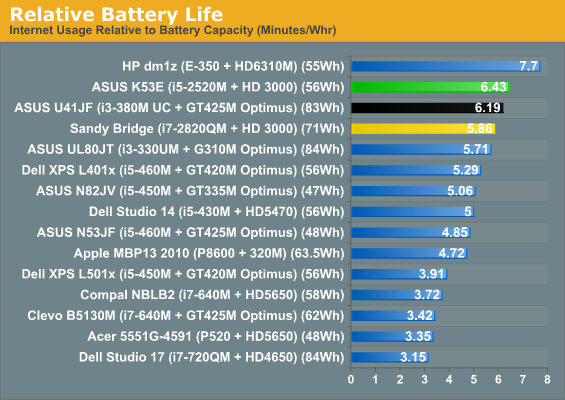ASUS K53E: Testing Dual-Core Sandy Bridge
by Jarred Walton on April 8, 2011 1:00 AM EST- Posted in
- Laptops
- Intel
- Sandy Bridge
- Asus
Battery Life: Minor and Major Improvements
As mentioned earlier, ASUS finally moved to something slightly higher capacity than the 48Wh batteries we’ve seen in so many entry-level notebooks. The result is better battery life, but compared to Arrandale it’s not a huge change in two of our tests. The third test is H.264 playback, and that shows a large increase in battery life. We’ve got the same laptops that we used in our application tests for these charts, but if you want more comparison points we suggest checking out Mobile Bench, where we have results for every laptop we’ve tested in the past year. For example, here’s how the K53E stacks up to one of the few Arrandale-only laptops we’ve tested, the Dell Latitude E6410.




The ASUS K53E places near the top of our battery life charts, with over seven hours of idle battery life, six hours of Internet surfing, and almost 4.5 hours of H.264 video playback. There’s still a sizeable gap between the K53E and laptops like the U41JF, but that’s more a case of battery capacity than efficiency. With a similar size battery capacity (and a much smaller LCD), HP’s dm1z does last over an hour more in the idle and Internet tests. H.264 content is a place where Sandy Bridge excels, however, and with only a 10 minute difference between the 11.6”-screen HP dm1z and the 15.6”-screen ASUS K53E it’s pretty clear that’s one metric where SNB is more efficient. Looking at relative battery life (i.e. true power efficiency), the K53E is only bested by Brazos (and Atom and CULV) in the Internet test. Even the U41JF can’t match the K53E for efficiency, despite underclocking the i3-380M to 700-900MHz (instead of the normal 933-1200MHz) and having a smaller 14” LCD.
For other battery life tests, the K53E lasted just 73 to 83 minutes in simulated gaming (looping 3DMark06/03, respectively), so at heavy loads SNB clearly isn’t a panacea. Setting the LCD to 100% brightness (instead of 50%, which corresponds with 100nits), idle battery life drops 10%. Put another way, the LCD uses an extra 0.87W at 205nits. That’s a very low figure for a 15.6” LCD, but then the maximum brightness isn’t very impressive and as we’ll see shortly, the LCD is otherwise a complete disappointment. Calculated power draw at idle running on battery power is just 7.91W, which used to be Atom territory (though the ASUS Eee PC 1001P drops that figure to just 4.4W). Internet surfing bumps the average power use to 9.33W, which is still extremely good, and H.264 playback requires 12.58W. We’re basically looking at 6-15 times the performance of Atom (Pineview), all while requiring just 40-80% more power at low loads. Connecting the AC adapter, we saw slightly higher power draw at the outlet, but mostly that comes from the AC adapter efficiency.
There are a couple final points before we leave power and battery life discussions. First, all of this testing was done with a stock Windows 7 installation, so we didn’t use ASUS’ Power4Gear utility to further optimize power requirements (e.g. by shutting off the DVDRW on battery power). In the past, that has usually added at least a few percent to the battery life, which is one of the reasons ASUS’ current laptops often beat their competitors.
The other interesting piece of information is that with Core 2 and Core 2010, we always achieved maximum battery life by setting the CPU to run at 0% minimum and 0% maximum in the advanced power settings (as opposed to 0% min/100% max). With Sandy Bridge, idle battery life still benefits slightly, but it’s within the margin of error (425 vs. 429 minutes); H.264 playback is also within the margin of error (261 vs. 267 minutes), but this time setting the CPU to 0% min/100% max results in the higher battery life. The real kicker is the Internet test: set to 0/0%, the K53E lasted 311 minutes compared to 360 minutes at 0/100%. In other words, with Sandy Bridge it looks like the “hurry up and go to sleep” principle is finally working as intended. This is a pattern we’ve noticed on other SNB laptops, so you can now get the benefits of faster instantaneous performance and better efficiency, at least when you’re running light loads.











78 Comments
View All Comments
Tasslehoff Burrfoot - Friday, April 8, 2011 - link
I'm a little surprised this laptop has such a long battery life.If manufacturers put as good batteries to the fusion laptops as Asus put into this one they could last a looong, loong time.
krumme - Friday, April 8, 2011 - link
I have 97 Wh on my 2520 machine, and it last 10-12 hr for office work. Its just a little bit short even for light gaming for my 2-3 years old games imho, but besides from that, it just delivers in spades. The fan is never on, and the laptop is not hot. Even decoding hd there is only very, very little heat and noise.silverblue - Friday, April 8, 2011 - link
I think comparing the following two ASUS models would make interesting reading:http://www.newegg.com/Product/Product.aspx?Item=N8...
http://www.newegg.com/Product/Product.aspx?Item=N8...
The former is a Pentium with HD 5470 discrete graphics and carries a $100 price premium (and has recently been reduced $200).
Acer do a cheaper Brazos laptop, however it's much larger at 15.6":
http://www.newegg.com/Product/Product.aspx?Item=N8...
789427 - Friday, April 8, 2011 - link
I don't know but I just may be getting old.To me the notebooks are pretty much all fast enough unless you're going for a desktop replacement and quite frankly, I can't see myself without a desktop (I like my 23" monitor but would never carry it around)
My on the go machine is a compaq 311c with 7200rpm 500gb HDD - a netbook and I never find myself apologizing for it's slowness.
So I asked myself, what makes a notebook noteworthy...
1. The right screen for the form factor
2. Battery life
3. Capabilities: can it play Blu-ray? 720p?
4. Is it fast enough?
5. does the keyboard work - or is it a Sony (Sorry Sony - you produced the worst keyboard ever in your netbook - can't remember the model)
When I saw the AMD video of the new processors when a video was playing, excel calculating the hind legs off a donkey on Mars and switching between the lot, I realized that Benchmarks are extremely limited and don't have a relationship to the real-world .
Real world benchmark: Hours of blu-ray playback
Can I type emails, letters while watching a windowed movie?
Can I watch while running a photoshop batch conversion? Text recognition?
And for a gaming laptop - what games can I play...
Am I nuts? Probably but somehow I think AMD is on to something. Oh wait... Apple is already there. How else could they charge the prices they do for a last-gen Intel CPU? It's by focusing on the entire build - especially the screen and design.
cb
Pirks - Friday, April 8, 2011 - link
Apple did the right thing getting rid of this legacy shit and I'm waiting for other molasses slow PC vendors to follow their lead. You don't need any stupid touchpad buttons when you have tap, multitap and multitouch on your touchpad, it's 2011 not 2001 for ducks sake, why use legacy tech now? I don't get it. I never ever touched touchpad buttons on my Asus UL80Vt since its touchpad has same left right middle click and scroll with multitouch, Apple-like and pretty nice and convenient to use.Stop being such a retro man Jarred, let the museum stuff go, will ya? ;)
JarredWalton - Friday, April 8, 2011 - link
No thank you... I hate the Apple touchpad where you actually have to physically "click" it. Anyway, my point was that I'm glad there's no silly rocker button (i.e. UL80Vt) this time. I also happen to do things like pushing the left button and then dragging over an area to select. Yes, you can double-tap-and-drag, but that sucks IMO. Anyway, you know what they say about opinions and a-holes. :)DanNeely - Monday, April 11, 2011 - link
I have to agree with Jarred. Tap to click == fail.ProDigit - Friday, April 8, 2011 - link
I wonder when the first manufacturer is going to create a HTPC, booksized pc, or mini pc, with a mobile Corei7 chipset, together with a powerful mobile graphics card, or a very energy efficient desktop graphics card!I think there'd be a lot of interest in a 64 or 128GB SSD, 2 or 4 x 4GB 1800Mhz DDR3 memory, the corei7 2820-QM processor, an ATI Radeon HD 5000 or 6000 series graphics card that is not the best of the best, but offers highest quality dx11 gaming for 1080p screens, or fluid dx9 gaming on 3 screens, together with IR sensor and remote control, and uses very little power in standby.
I see plenty of sub $100 variants with too slow processors to play back 1080p video on a tv.
drajitsh - Saturday, April 9, 2011 - link
posting after nearly 10 years.Well having followed Anandtech continuously for 11 years I do know a little bit about computers. therefore I get a pretty fair idea of the performance from the specs online and most vendors will give pics of their systems so any glaring ergonomic defects will be visible.
Since sandybridge I just read the initial review for the platform, the for the subsequent reviews I go directly to the screen review. If, as is usually the case, the screen is pathetic I go back to my Galaxy Tab.
I am a surgeon, so my tablet and my old core 2 duo more than take care of the bulk of my needs -- mainly web surfing, having memorised the keyboard shortcuts I find the ribbon interface clunky and obsteperous and even office 97 would probably do all the work I need.n hence open office and google docs.
I am making do with my core 2 duo -- nice keyboard ( with real keys and not a chiclet monster) a 16:10 screen ( I have other options if I want to see movies and I like to see more of the webpages or documents). the one thing I cannot indulge is my hobby of photography. Probably will continue doing so till they come out with something with a better screen with a Adobe RGB gamut and taller than 16: 10.
I guess I will be waiting for sometime still.
ProDigit - Saturday, April 9, 2011 - link
quote:"There’s little (well, nothing really) to recommend an Atom netbook over a Brazos alternative at the $300 to $350 price bracket"
You forget battery life, which is important for many!
Atom netbooks have very low latency in audio applications, and have a long battery life.
I rather pay $300 for a netbook that does basic computing for 10 hours, than pay $400 for a neo that can do basic gaming, but only lasts 4 hours on battery!